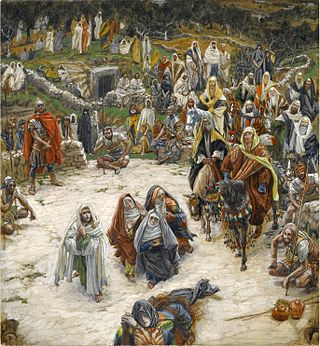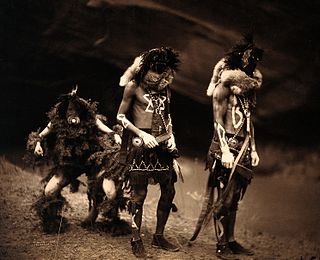Related Research Articles

The Hopi are Native Americans who primarily live in the southwestern United States. The majority are enrolled in the Hopi Tribe of Arizona and live on the Hopi Reservation in northeastern Arizona; however, some Hopi people are enrolled in the Colorado River Indian Tribes of the Colorado River Indian Reservation at the border of Arizona and California.

In religion, a prophecy is a message that has been communicated to a person by a supernatural entity. Prophecies are a feature of many cultures and belief systems and usually contain divine will or law, or preternatural knowledge, for example of future events. They can be revealed to the prophet in various ways depending on the religion and the story, such as visions, divination, or direct interaction with divine beings in physical form. Stories of prophetic deeds sometimes receive considerable attention and some have been known to survive for centuries through oral tradition or as religious texts.

The Hopi maintain a complex religious and mythological tradition stretching back over centuries. However, it is difficult to definitively state what all Hopis as a group believe. Like the oral traditions of many other societies, Hopi mythology is not always told consistently and each Hopi mesa, or even each village, may have its own version of a particular story, but "in essence the variants of the Hopi myth bear marked similarity to one another." It is also not clear that the stories told to non-Hopis, such as anthropologists and ethnographers, represent genuine Hopi beliefs or are merely stories told to the curious while keeping safe the more sacred Hopi teachings. As folklorist Harold Courlander states, "there is a Hopi reticence about discussing matters that could be considered ritual secrets or religion-oriented traditions."
Destiny, sometimes also called fate, is a predetermined course of events. It may be conceived as a predetermined future, whether in general or of an individual.

The sayings of Jesus on the cross are seven expressions biblically attributed to Jesus during his crucifixion. Traditionally, the brief sayings have been called "words".

In astronomy, axis mundi is the Latin term for the axis of Earth between the celestial poles.

Mayanism is a non-codified eclectic collection of New Age beliefs, influenced in part by Pre-Columbian Maya mythology and some folk beliefs of the modern Maya peoples.
Leland Jensen was the leader of a small apocalyptic cult called the Baháʼís Under the Provisions of the Covenant (BUPC). Jensen was originally a member of the mainstream Baháʼí Faith until he was excommunicated in 1960 for supporting Mason Remey's attempt at schism. He later left Remey's group due to infighting and began teaching that he would re-establish the Baháʼí Faith after a nuclear holocaust, which he predicted would occur in 1980. At its peak, his movement had 150-200 followers, mostly in Montana, but declined in size significantly by 1990 and beyond.
Since the early 1970s, a legend of Rainbow Warriors has inspired some environmentalists and hippies with a belief that their movement is the fulfillment of a Native American prophecy. Usually the "prophecy" is claimed to be Hopi or Cree. However, this "prophecy" is not Native American at all, but rather from a 1962 Evangelical Christian religious tract, titled Warriors of the Rainbow by William Willoya and Vinson Brown from Naturegraph Publishers. Brown is also the founder and owner of Naturegraph Publishers. Discussing the legend, scholar Michael Niman said, "If anything, it was an attack on Native culture. It was an attempt to evangelize within the Native American community."
The traditional Maya or Mayan religion of the extant Maya peoples of Guatemala, Belize, western Honduras, and the Tabasco, Chiapas, Quintana Roo, Campeche and Yucatán states of Mexico is part of the wider frame of Mesoamerican religion. As is the case with many other contemporary Mesoamerican religions, it results from centuries of symbiosis with Roman Catholicism. When its pre-Hispanic antecedents are taken into account, however, traditional Maya religion has already existed for more than two and a half millennia as a recognizably distinct phenomenon. Before the advent of Christianity, it was spread over many indigenous kingdoms, all with their own local traditions. Today, it coexists and interacts with pan-Mayan syncretism, the 're-invention of tradition' by the Pan-Maya movement, and Christianity in its various denominations.

The Dark Wind is a crime novel by American writer Tony Hillerman, the fifth in the Joe Leaphorn/Jim Chee Navajo Tribal Police series, published in 1982. It is the second of the novels to feature Officer Jim Chee.

Native American religions are the spiritual practices of the Native Americans in the United States. Ceremonial ways can vary widely and are based on the differing histories and beliefs of individual nations, tribes and bands. Early European explorers describe individual Native American tribes and even small bands as each having their own religious practices. Theology may be monotheistic, polytheistic, henotheistic, animistic, shamanistic, pantheistic or any combination thereof, among others. Traditional beliefs are usually passed down in the forms of oral histories, stories, allegories, and principles.
The 2012 phenomenon was a range of eschatological beliefs that cataclysmic or transformative events would occur on or around 21 December 2012. This date was regarded as the end-date of a 5,126-year-long cycle in the Mesoamerican Long Count calendar, and festivities took place on 21 December 2012 to commemorate the event in the countries that were part of the Maya civilization, with main events at Chichén Itzá in Mexico and Tikal in Guatemala.
Sacred waters are sacred natural sites characterized by tangible topographical land formations such as rivers, lakes, springs, reservoirs, and oceans, as opposed to holy water which is water elevated with the sacramental blessing of a cleric. These organic bodies of water have attained religious significance not from the modern alteration or blessing, but were sanctified through mythological or historical figures. Sacred waters have been exploited for cleansing, healing, initiations, and death rites.
Thomas Banyacya, Sr. was a Hopi Native American traditional leader.
David Monongye was a Hopi Native American traditional leader. Nephew of Yukiuma, keeper of the Fire Clan tablets, who founded Hotevilla in 1906. He is one of four Hopis who decided or were appointed to reveal Hopi traditional wisdom and teachings, including the Hopi prophecies for the future, to the general public in 1946, after the use of the first two nuclear weapons on Japan.
Dan Katchongva was a Hopi Native American traditional leader. Son of Yukiuma, keeper of the Fire Clan tablets, who founded Hotevilla in 1906. He is one of four Hopis who decided or were appointed to reveal Hopi traditional wisdom and teachings, including the Hopi prophecies for the future, to the general public in 1946, after the use of the first two nuclear weapons on Japan. Katchongva was the eldest of the group of four knowledgeable Hopis, and the first to die. Kachongva was a member of the Sun Clan.
Ancient Prophecies is a series of four TV specials that aired on NBC between 1994 and 1997. Hosted by David McCallum, each special focused on apocalyptic prophecies of doomsday leading up to the year 2000, including interviews and reenactments.
References
- ↑ Mails, Thomas E. (1997). The Hopi Survival Kit
- ↑ Ghost Wolf, Robert (2003). Days of Destiny: Cosmic Prophecies for the 21st Century. Trafford Publishing. pp. 132–138. ISBN 1412007267.
- ↑ Smith, Scott S. (August 1997). "Thomas Mails Last Stand". Orange Coast Magazine . Emmis Communications. 23 (8): 80–85. ISSN 0279-0483.
- ↑ Mercier, Patricia (2008). The Maya End Times: A Spiritual Adventure to the Heart of the Maya Prophecies for 2012. Duncan Baird Publishers. ISBN 978-1780283357.
- ↑ Techqua Ikachi